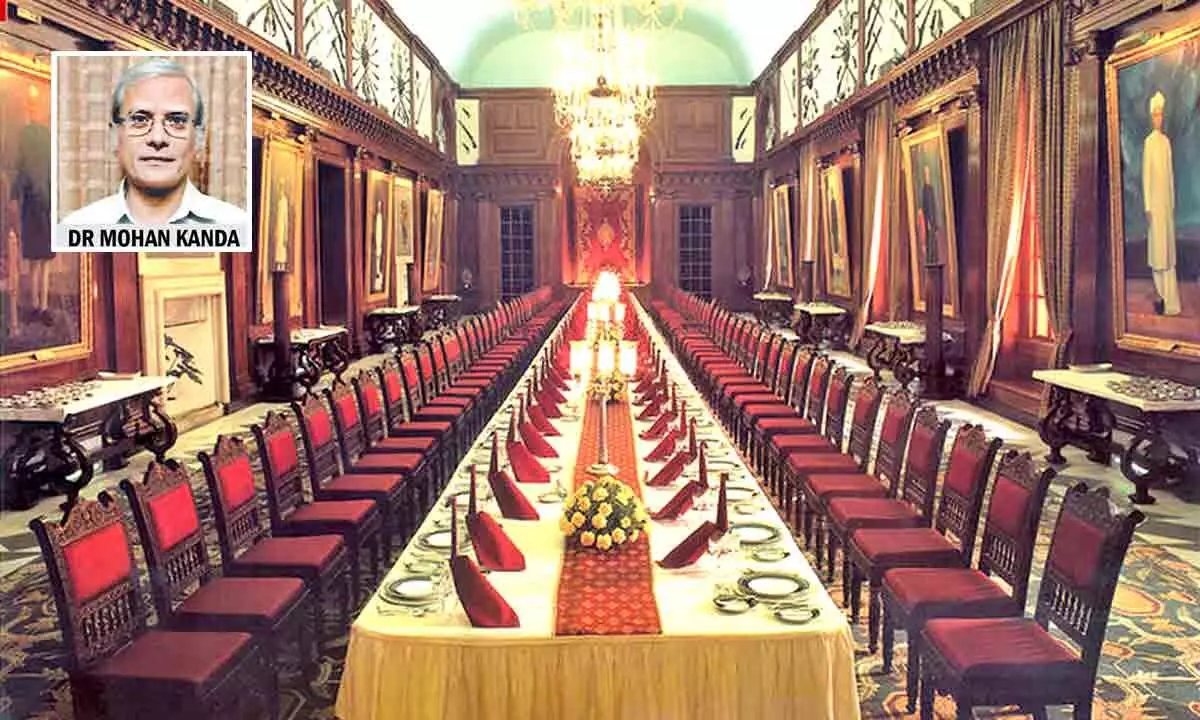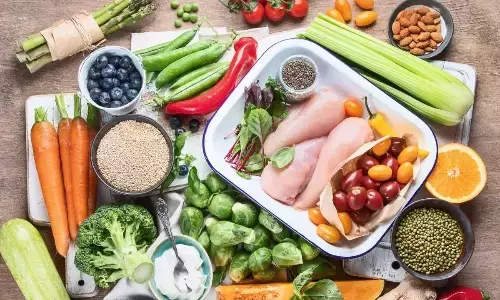Mouth-Watering Feasts Across Cultures and Occasions

Mouth-Watering Feasts Across Cultures and Occasions
Explore lavish spreads from Andhra weddings to state banquets and fond memories of meals in India. A dive into global and local culinary traditions.
Leaving aside the injustice aspect of the subject of food, let us take a look at how mouth-watering spreads are offered in different countries and on festive vacations.
To begin with an example belonging to the realm of fantasy, one recalls a scene from the evergreen movie, ‘Maya Bazar’, of 1957 vintage. Ghatotkach, the son of the Pandava warrior Bheem in the epic Mahabharat, and a true gourmet, figures in one scene, feasting gloriously from a meal prepared for a wedding. Singing heartily as he gorges on an array of succulent preparations, Ghatotkach enjoys himself immensely. And the spread on offer is a classical Andhra wedding meal comprising, apart from various types of rice preparations, Vada, various types of vegetable curries, rasam and sambar, for which the Southern states are so popular, fryums, coconut chutney, Andhra sweet stuffed Paratha also called a Bobbattu, and, of course, the much-feared Avakaya, the mango pickle which the Andhras love, and which gives the rest of the world the jitters. And last, but not the least, the powder made with pigeon pea, also fondly called gun powder, for the wallop it packs. Such a spread is also known as ‘Mrishtanna Bhojan’.
In the Andhra wedding meals, a strict protocol is followed in regard to the seating arrangement. The bridegroom’s party is given precedence and seated in a line which is served first. Guests come next, followed by the bride’s family, friends and relatives.
The Andhra Pradesh example is just one among many. Equally elaborate, and carefully planned, wedding events, are common in other states as well, such as Kerala, Tamil Nadu, West Bengal and Punjab. And the fares offered are also equally varied, and wholesome, apart from being extremely friendly to the palate.
While on the subject of meals, one recalls the banquets at Raj Bhavan, Hyderabad, during my tenure as Secretary to the Governor of Andhra Pradesh, and those at Rashtrapati Bhavan, while I was working as Secretary to the Vice President of India; all elaborately planned affairs, with meticulous seating plans, strictly according to protocol. A rose flower was placed to the left of the guests to indicate his or her being a vegetarian. The interesting part was that a green light would come on, the minute a dish was placed before the Chief Guest, and be replaced by a red one, as soon as he or she finished. Whether one had finished eating one’s dish or not, one had to surrender the plate and wait for the next course! Liveried staff were in attendance for the service and one enjoyed the meal to the accompaniment of soothing background music played by a military band.
With much less ado, in terms of the ambience, and far less in regard to expense, were the lunches I had in my college days. From Nizam College, I would walk either to the popular Taj Mahal Hotel, or, literally next door, the Kwality’s. I enjoyed the princely daily allowance of 3 rupees. Generously provided by my mother, those days. The rickshaw journeys, from home to Nizam College, and back, took away eight annas each. Still, one had enough left, to enjoy a sit down unlimited vegetarian meal at the Taj, or an a la carte one at the Kwality’s. The taste still lingers on one’s palate, though neither of them was anything like the seven course meals one can enjoy a high-end restaurant, which begin with a hors d’ouevres, and proceed from soup through appetiser, salad, main course, desert, and mignardise, to sweets. And when the lunch was followed by the delicious. and typically Hyderabadi, ‘meetha pan’, one’s cup of joy was full!
The meals at the mess at the National Academy of Administration, during my training days as an OT, are worth recalling in this context.
The establishment made every effort to introduce the OTs to the different varieties of food popular in various parts of the country. The idea was to get them acclimatised not only to eating, but cultivating a healthy taste for, all kinds of fare, as we could have been allotted to the cadre of any state in the country for the rest of our careers. An effort was also made to wean OTs away from any strong preferences, or prejudices, which they may have brought with them to the Academy. The menus were also such, especially at breakfast, that one would get accustomed to beginning a day with a healthy, nutritious and wholesome meal, no matter wherever one was posted later on.
One ate cornflakes, or oats, with milk, eggs, or cutlets, if a vegetarian, toast with butter, and coffee or tea. As a measure of compensation for the somewhat uncompromising regimen, snacks were made available in the afternoons, catering to different tastes, items such as samosas, Dosas, Pakodas, etc., on every other day, there was what was known as a dry lunch, when no roti or rice was served and, a typically western style fare was offered, with soup, mayonnaise and vegetarian or non-vegetarian chops, etc. Senior members of the faculty often joined us at the meals, keeping an eye on the quantities and quality, and making sure that table manners were being duly observed.
Heard melodies, said the poet Keats, are sweet, and those unheard, sweeter. Likewise, one meal I never had, is the one whose imagined taste still lingers in my memory tantalizingly, one day, during one of my routine tours of villages in my jurisdiction as Sub Collector, I had reached a village around lunchtime. The Karanam or the Village Officer in charge of accounts, offered lunch to me. I declined as it was against my principles to accept any hospitality, even a cup of tea or coffee, from anyone. Every morning, before I started, food made at home used to be put in a hot box which I carried with me, On that day, however, the box had been left behind in the Guest House which was more than a couple of hours away. When I declined the offer, the Karanam bluntly told me that he had felt it his duty, to offer a meal to a hungry person, adding, rather sarcastically, that compared to the kind of guests he had entertained in the past, it was nothing special. Hungry, and somewhat humbled, I made my way to the Guest House.
While on a much-awaited holiday in France, a couple went to a classy restaurant for lunch. Keen to show off his recently acquired prowess in the French language, the husband placed the order in French. And the cartoon about the story shows the waiter bringing a nude lady on a big plate and the wife chiding the husband saying, “John, I told you not to order in French!”
(The writer was formerly Chief Secretary, Government of Andhra Pradesh)















